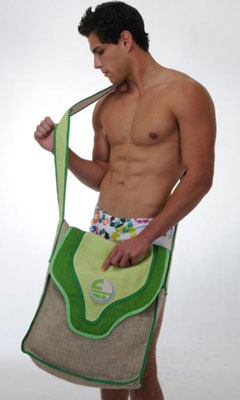from trash to luxury
Ecomoda, green labels, green, sustainable or ecological fashion. Whatever! The important thing is to wear your shirt for the environment
Pet bottles become blouses. Film films become handbags. Traditional Amazonian plant becomes 100% ecological fabric. Hard to believe? There's nothing like creativity, good taste and avant-garde thinking for designers to bring ecologically correct fashion to the catwalks and everyday life.
The accessories use recycled material and the clothes are made from natural fibers, dyes and fabrics, which during production do not use chemicals, fertilizers, pesticides or any product harmful to nature.
Designer Rubia Calazans recycles film film, a material that takes more than 100 years to degrade, to make bags, tops, necklaces, among others. "I started recycling with K7 tapes, photographic film and then came the film. Reusing has always been part of my life context", says the carioca who has been doing this work for 6 years.
In all Rubia pieces, the finishes are done manually. A team that carries out the initial process, but the finalization is up to the designer. The recycled material is worked with crochet stitches, velcro closures or metals. In addition to being an attitude that nature is grateful for, Rubia explores the transparency, opacity and brightness of the film, making it possible to visualize the images from the films.
In the case of fabrics, there is an example of successful research that reflects the effort and dedication of designer Caio Von Vogt. Approximately 10 years ago, he created the world's first 100% ecological and organic fabric, EcoVogt, with international patent and registration. This is manufactured by Companhia Têxtil de Castanhal and made from jute fiber, a plant grown in the Amazon.
Initially, jute was only used in the production of bags, carpet lining, interlining and others. Based on the research developed by Von Vogt, it is now possible to use it to make t-shirts, ecobags (bags that replace plastic bags), belts, etc. "The benefit of EcoVogt is that in contact with nature it only takes 2 years to degrade, while synthetic polyester fibers take 100 years. Plastic 500 and cotton 10", says the fashionable designer.
What makes EcoVogt fabric 100% ecological and organic is the process of using fixatives and softeners extracted from native Brazilian plants when dyeing. These are plants such as saffron, brazilwood, annatto, among others, which feature a 12-color palette.
For Von Vogt, what helped change the culture of recycling and makes people aware is the "I'm not plastic" campaign, which initially came from Europe and the USA with the intention of eliminating plastic bags with bag options when carrying your purchases. "This came to clarify people's ideas", says the stylist.
However, he states that in Brazil we have a cultural problem. "It is not possible to change certain habits overnight, such as turning off the tap when brushing your teeth or taking a quick shower. For many it is still utopian to say that there will be a lack of water, as for now it is not a real need", explains Von Vogt. Still, he hopes that the next generations will be more aware, since this whole socio-environmental problem is very recent in Brazil, but tends to be passed on in the education of today's children.
On the Catwalks
At São Paulo Fashion Week, in June, Oskar Metsavaht, designer at Osklen, caused a stir by using leather and plastic in his collection. But, according to the Rio designer, known for being a pioneer of sustainable fashion, the pieces served to raise awareness about what ecologically correct fashion actually is. Metsavaht recycled the plastic to make hats, vests and hoods.
Leather was used because there is an overpopulation of alligators that affects the imbalance of fauna in the Amazon. So, many institutions slaughter the animals, leave the meat with the local population and use the skin for fashion. In addition to being a stylist, Metsavaht is a doctor and created Institute E to evaluate materials that do not affect the environment and that can be used by the fashion industry.
At SPFW, the reuse of materials was also a theme for the brands Maria Bonita, UMA and Jefferson Kulig. The first used organic fabrics and natural fibers, while UMA recycled pressed rubber on taffeta and Kulig mixed technological and organic elements creating the expression techno-organic.
Eco Fashion Brasil
For university students or recent fashion graduates who are thinking about making conscious clothes, a good option is to participate in the Eco Fashion Brasil competition. This is the case of student Romania Ishiyama, who believes it is necessary to think about sustainable fashion. "As a student and future professional, I have a responsibility and obligation to help the industry find less aggressive solutions", says Romênia.
The university student will portray the Atlantic Forest in her collection, which was preserved in Itacaré (BA) and for this she will use organic fabric, coconut fiber, jute, among others. The competition uses the inclusion of the idea of sustainability in the fashion industry as a selection criterion. Regarding the benefits that Eco Fashion Brasil brings, Romania says that it is initiatives like this that reflect where we need to go. "The textile industry needs to learn to take care of the environment", says the student.
Rubia Calazans http://www.byrubiacalazans.com
Caio Von Vogt http://www.caiovonvogt.com.br
Eco Fashion Brasil http://www.ecofashionbrasil.com
* Article originally published in issue #16 of the magazine The Cape Special Environment – September 2008


